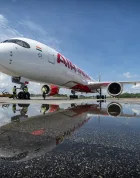As dedicated readers will know, while I sometimes paint a picture of a champagne-fuelled extravagant travel lifestyle thanks to Miles & Points, I also emphasize the reality that success in this pursuit requires plenty of time and effort to achieve.
Nothing worthwhile in life comes easy, and using points to elevate your travel is no exception, with plenty of frustrations along the way that are guaranteed to leave you wanting to pull your hair out at some point. Wherever you are along the journey, it’s inevitable that one of these frustrations will rear its ugly head at some point, so let’s take a look at what they might look like when the time comes, and what you can do to mitigate them.
In This Post
- 1. Declined Credit Cards
- 2. Minimum Spending Requirements
- 3. Financial Reviews
- 4. Targeted Offers
- 5. Searching for Awards
- 6. Limited Award Availability
- 7. Carrier-Imposed Surcharges
- 8. Married Segments
- 9. Awkward Travel Schedules
- 10. That Feeling of Wanting More
- Conclusion
1. Declined Credit Cards
No matter how good your credit score is, everyone will get declined for a credit card at some point, and it’s a particularly bitter feeling when you’ve been hoping to earn a mouthwatering signup bonus to get you closer to booking that big trip.
Even now, whenever I apply for a new credit card, my heart starts racing a bit when I click the Submit button and that little dial starts spinning round and round. It just feels like so much is on the line, doesn’t it?

Of course, an instant approval leaves you feeling mighty proud of yourself, while a message along the lines of “we need to review your application and are not able to provide a decision at this time” can be slightly disheartening. With American Express cards, it’s frankly quite rare to get declined outright, and it’s usually just a matter of speaking to the New Accounts team over the phone to make sure that it was indeed you who made the application.
With other issuers, that might be the case as well, or they might genuinely have declined your application for whatever reason. If that happens, definitely get on the phone and try to figure out why you were declined, and whether or not they’d be able to reconsider your application. Some issuers, like MBNA, are happy to split off any existing credit limits to push through the application even if they don’t wish to extend you more credit.
If they remain steadfast in denying you that sweet sweet signup bonus, it could be a sign to lay low for a while and undergo a cooldown period (usually three months will do) before launching into more credit card applications.
2. Minimum Spending Requirements
The Business Platinum Card has a signup bonus of 75,000 Membership Rewards points, enough for a round-trip to Asia all on its own. Wonderful. But you need to spend $7,000 within three months to earn that bonus in the first place, and that’s a lot of money to spend.
Indeed, one of the biggest steps along the journey from a Miles & Points beginner to a more advanced participant is learning to make light work of minimum spending requirements.

When you’re just starting out, you tend to plan your credit card applications around whether or not you can meet the minimum spends, but once you get to a more advanced level, you simply go for the big bonuses whenever you want, knowing that the minimum spends won’t be an issue.
3. Financial Reviews
99% of you will likely never have to undergo a financial review, but it’s still worth knowing about it in the unlikely event that it happens.
A financial review is when an issuer takes an in-depth look at your credit card accounts, usage, and spending patterns, as well as your income and debt situations, in order to assess if you are creditworthy enough to remain a customer. They’re usually triggered by suspicious spending patterns, like spending far beyond your stated annual income, cycling through your credit limits quickly, or putting huge charges on your credit card as a new customer.

That last point seems to be a very common trigger for financial reviews: if you’ve just opened a Business Platinum Card as your first-ever Amex card, don’t put a $7,000 charge on it during the first week – that’s a certain way to raise suspicion as to whether or not you’d be able to pay that balance back.
During a financial review, you’ll likely be asked for documents like pay stubs and bank account statements. While it can be a stressful experience, most people emerge from financial reviews unscathed. However, Amex has been known to occasionally ask cardholders to close your business credit cards if they don’t have a legitimate business.
Like I said, the chances are minimal that a financial review could happen to you, but it’s worth knowing about and taking steps to fly under the radar.
4. Targeted Offers
Here’s a minor frustration that you’re bound to encounter at some point: airlines, hotels, and credit card companies often put on spectacular offers, but only for a certain segment of their customer base that they’ve determined is the right “target” for these offers. It’s not fun at all to see others enjoying these lucrative offers while you’re left on the sidelines.
As an example, until May 31, Marriott Bonvoy is running a few targeted elite qualifying night offers for some of its members. One of these offers allows you to earn Double Elite Nights on all your paid stays, which can be an incredible way to fast-track to Platinum Elite status, at 50 elite qualifying nights for the year, and start enjoying benefits like free breakfast and suite upgrades along your hotel stays.

If you received this offer, don’t miss out on the opportunity to earn Platinum status for only 13 paid nights (once you take into account the 15 nights you earn from holding the Amex Bonvoy Card or Amex Bonvoy Business Card and the 10 nights from booking a meeting or event). But sadly, if you didn’t receive the offer, there’s not much you can do besides hoping for better luck next time.
5. Searching for Awards
Arguably, the frustrations only start to add up more quickly once you’ve earned the points and are looking at redeeming them for travel.
First off, how needlessly difficult is it to search for – let alone book – award travel? If you’re paying for flights, you can hop onto Google Flights and plan your trip with a nice, clean interface. But if you’re redeeming points, you must work with clunky interfaces like the Aeroplan search engine, or more advanced tools like ExpertFlyer that come with a not-insignificant learning curve.
Then you have the countless caveats and asterisks associated with different airlines programs and partners, like the fact that the Alaska search engine can’t see Cathay Pacific or LATAM award space, or the British Airways Avios search engine can’t see Alaska Airlines or Aer Lingus award space.
Thus, you’re forced to use another airline’s website to search for award space, before calling your desired loyalty program to book the ticket (for example, you’d search for Cathay Pacific space using the Avios or Qantas website, or Aer Lingus space using the United website).

Imagine a perfect world in which award space from all partners could easily be accessed through a Google Flights-style search portal, with instant results, calendar views, and filters for airlines, fuel surcharges, mixed cabins, and excessive connections. Wouldn’t that be a nice world to live in?
Of course, all the availability would probably get snatched up more quickly, so maybe that’s the silver lining: the more byzantine the process to redeem points for flights, the more available space remains for those of us who are willing to put in the work.
6. Limited Award Availability
The convoluted search process is one thing, but what about the award availability itself? Slim pickings, eh?
Airlines generally make their “distressed inventory” available as awards, meaning the seats that they aren’t confident will be sold for revenue. That means that the amount of available seats for you to redeem miles is naturally going to be a small fraction of the available seats for sale, and once these seats are taken by other travellers who are redeeming points, there’s no guarantee they will return.

With most airlines, award availability will be the most plentiful at the beginning of the schedule (10–12 months before the date of departure), and as the date of travel approaches, these will gradually get booked up. Once we’re within 1–2 weeks of departure, airlines will often release additional seats that are likely to go unsold into the availability pool.
However, different airlines all manage their inventory differently, so there’s no real sense in over-analyzing availability patterns. For example, in planning a trip recently, I noticed that Turkish Airlines had wide-open business class space on many North American routes in late 2019, until one day when they suddenly removed all the award space on those flights (there was no chance that entire months’ worth of space was booked up overnight; it had to be a decision from revenue management).
Instead, the rule of thumb is to maintain a high degree of flexibility when planning your travels and you’re generally able to find something you’re happy with. Don’t commit to a specific date, airline, routing, or even destination, and you’ll be much more likely to score an awesome trip and extract a high value out of your miles.
Provided, of course, that you can deal with the next few frustrations…
7. Carrier-Imposed Surcharges
Fuel surcharges, or carrier-imposed surcharges, are frankly quite insulting to the members of a loyalty program. Existing purely to line the pockets of the airlines, they can instantly suck the fun out of redeeming your miles when you discover that you must pay a further $1,000 for your supposed “reward” flight.
Thankfully, one of the first things you learn along your Miles & Points journey is the fact that you can sidestep these surcharges by choosing your airlines wisely. When redeeming Aeroplan miles, you’ll avoid the heavy-hitting fuel surcharges as long as you steer clear of Air Canada, Lufthansa, or Austrian Airlines for your long-haul flights.

Alternatively, you can also get some of the world’s governments to do the work for you, by starting your trip from a country that has implemented regulations to rein in this anti-consumer practice.
Personally, I’m wiling to pay about $100–200 in fuel surcharges if it’s the best option available (like, say, direct flights to Beijing on Hainan Airlines using Alaska miles, which come with about US$150 in surcharges), but it still leaves a bad taste in the mouth.
8. Married Segments
When you’re searching for award flights, married segments is one of those annoyances that just make you want to smash your head against a wall.
A married segment occurs when an airline makes award space on a certain flight available only when you’re connecting onto a different flight. So if you were to search, say, New York JFK to Zurich, you’d find no direct flights…

…but if you were to search New York JFK to Vienna, you’d find an itinerary that routes you via Zurich.

Of course, that’s not useful to you if you wanted to get to Zurich, and the endlessly frustrating part is that there’s clearly award space available on the flight to Zurich, but Swiss doesn’t want you booking it on its own.
In this scenario, Swiss is confident of selling a direct flight on JFK–Zurich for cash, but it’s less confident of selling the connecting journey to Vienna to a paying customer, so it decided to make that routing available as an award.
Presumably, it could charge much more on the direct flight as well, thus lowering its incentive to make the direct flight available for a mileage redemption. That’s the logic that the airlines use, anyway, but I find it completely unintuitive since it’s the same seat on the plane either way.
Within the Aeroplan ecosystem, I’ve generally witnessed Swiss and TAP Air Portugal as the worst offenders when it comes to using married segment logic, and I’ve also seen quite a few Oneworld partners employ this practice when redeeming British Airways Avios. If you do encounter this annoying tactic, it’s worth calling the loyalty program to see if they can “break” the married segment manually and build your itinerary from there.
9. Awkward Travel Schedules
Because of all the challenges associated with redeeming points, it’s inevitable that you’ll have to deal with a few awkward travel schedules along the way.
When you’re paying cash for your travels, you can choose from any flight, at any time, on any airline. But when redeeming points, you’re dealing with already limited award inventory, among which the most “desirable” flights tend to get snapped up the quickest. This means that it can often come down to a decision of whether to accept an exhausting 6am departure from an airport that’s 50km out of town, or whether to take the trip at all.

Other examples of awkward travel schedules might include red-eye flights, midnight arrivals, forced overnight stays, or connection times of six to nine hours, which is a long time to spend at the airport but also not really enough time to spend exploring the city.
While these situations may be inconvenient, I generally think of them as a small price to pay if the alternative is that you aren’t able to book the trip at all. If I’m already redeeming my miles for travel at a spectacular value, I can quite easily go with the flow without being overly concerned about a few early mornings or late nights. After all, no matter where you are in the world, a cup of coffee can never be too far away.
10. That Feeling of Wanting More
So you’ve earned enough points for a big round-the-world trip. You’ve sampled some of the best airlines in business class, and treated yourself and your loved ones to an unforgettable trip. Maybe you even have a few more upcoming trips already booked. But what’s next?
You’ve had an awesome time on EVA Air business class and staying in Renaissance and Hilton hotels, but what if you want to spend the next trip indulging in ANA First Class and living it up at St. Regises and Waldorf Astorias instead?

And perhaps more importantly, how do you ensure that you can continue travelling in this fashion indefinitely –because, let’s face it, once you’ve treated yourself to business class, it’s kind of a bummer to go back to flying long-haul economy? How do you take your game to the next level, and ensure that this amazing experience was not just a one-off?
I very clearly recall grappling with these questions when I was first starting out with Miles & Points. After all, realistically speaking, you can only cycle through the major credit cards at a certain pace, even if you do scale up using two-player mode or more.
Beyond that, once again, we go back to building those personal relationships with your fellow travellers and points collectors and learning new tricks through your network of friends.
If you do find yourself feeling that itch for more and more points-fuelled adventures, then establishing a strong network and finding out about opportunities before they become public is how you go about satisfying those particular cravings.
Conclusion
If it were easy to come out ahead in Miles & Points, then everyone would be doing it, and the profit-seeking airlines, banks, and credit card companies would leave us with very little to play with. Indeed, there are many hurdles to be overcome in both the earning and redeeming sides of the game, many of which might leave you briefly wishing you had never started doing this and were simply content paying cash for travel in the first place.
But with research, experience, and lots and lots of patience, you come to realize that these frustrations are all part of the journey, and they only make it ever more satisfying when you’re clinking your champagne glasses across the aisle, ready to embark on yet another new adventure.




















